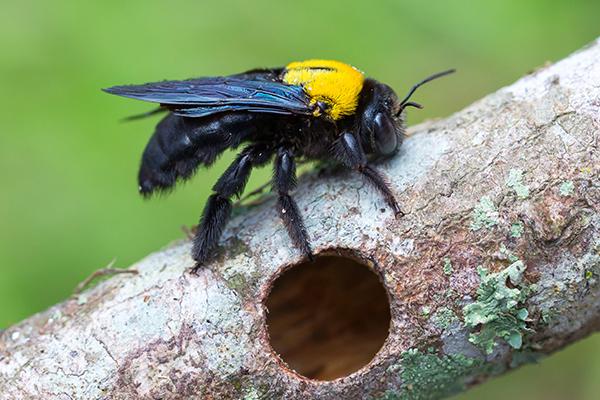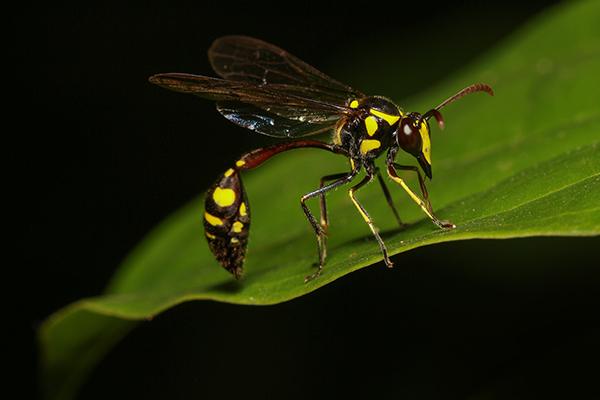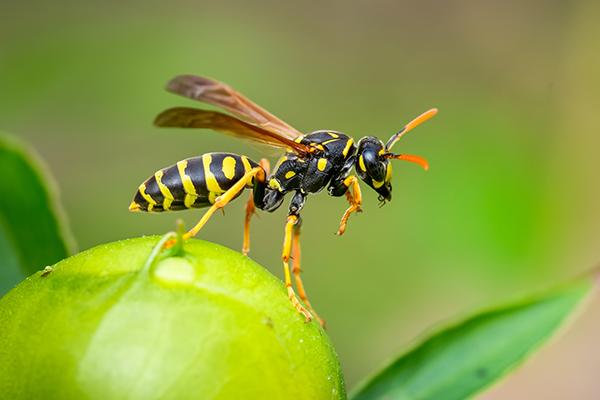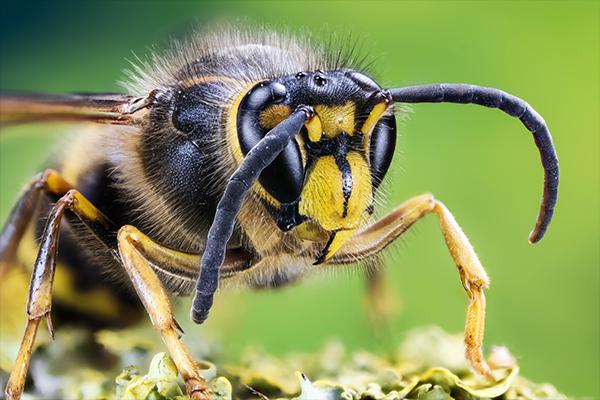
Stinging Insects
Common types of stinging insects in South Carolina
Stinging insects are beneficial when nesting out in nature away from people and their homes. They are responsible for pollination and predatory species help to keep nuisance insect populations down. But, when stinging insects build their nests close to our homes or even inside our homes, they can become quite dangerous.
There are many different species of stinging insects that can be found living in and around homes in Lexington, Columbia, and the Midlands of South Carolina. Some helpful information about the most common species of stinging insects in South Carolina as well as some professional stinging insect prevention tips is listed below.
Helpful Articles
Carpenter Bees

Carpenter bees are large in size. Their large size often causes these black and yellow bees to be mistaken for bumble bees because of their similar appearance. However, carpenter bees have smooth, shiny, black abdomen, unlike bumblebees whose abdomens are fuzzy and yellow.
Carpenter bees are a solitary species. The females create their individual nest by drilling a hole the diameter of her body and tunneling inside older or untreated pieces of wood. They are commonly found nesting in wooden decks, fence rails, wooden trim and furniture, overhangs, and window sills.
Females are equipped with a stinger but are very docile and rarely sting. Luckily, the males have no stingers. This is a fortunate circumstance as males are much more aggressive and would be more likely to sting if able.
Mud Daubers

Adult mud daubers are a large species of stinging insect. Adults can grow to between 1 ½ and 2 inches in length. They have a narrow waist, with a thread-like segment connecting the thorax and abdomen. These solitary stinging insects create their nests out of mud and other natural materials. Mud daubers range in color from black to metallic blue, depending on the exact species, and they may or may not have yellow or green colored markings.
Yellow Jackets

Yellow jackets are a predatory species of stinging insect that feed on a variety of other insects including flies, caterpillars, and grubs. Adult yellow jackets have a segmented, hairless body with a distinct, thin waist. Their wings are elongated and, when at rest, fold laterally against their body.
Yellow jackets have faces and heads that are a color-blend of black and yellow, while their bodies have a well-defined yellow and black striped pattern. Yellow jackets are typically ground nesters, though some will build above-ground nests on houses and buildings, or in bushes and trees with low-hanging limbs.
Hornets

Hornets are known for being extremely aggressive and unhesitatingly attacking any perceived threat, whether to an individual or to their entire nest.
European hornets are the only true species of hornet found living in the United States. They have long, strong bodies that are brown in color with yellow abdominal stripes and their faces are pale in color.
Adults grow to between ¾ and 1 ½ inch in length. They prefer to create their nests inside cavities found in wall voids, attics, hollow trees, or in between rocks.
Our FAQ
Have questions? We are here to help. Still have questions or can't find the answer you need? Give us a call at 803-921-8829 today!
-
How do you prevent stinging insects?
It can be very difficult to keep stinging insects from nesting on your property. The following tips can help to lessen your family's contact with these potentially dangerous pests:
- Make sure that all chimneys have tight-fitting covers on them.
- Caulk any holes found in the exterior of your home and fill in any spaces found around utility lines and pipes entering your home through its exterior.
- Stain or paint wood surfaces to deter carpenter bees from drilling holes and nesting inside.
- Make sure all outdoor trash cans have tight-fitting lids on them to prevent stinging insects from foraging for food inside them.
- Clean up all leftover food and drinks after eating outside.
- Remove old dead or fallen trees and trees stumps from your property, as they could be used as nesting sites for stinging insects.
- Plant flowers and flowering vegetation on your property away from your home.
-
How do you get rid of stinging insects from your property?
To remove a problematic stinging insect nest from your property in the safest manner possible, contact a professional pest control company for home pest control and commercial pest control services, like us at The Original Bugman Pest Elimination, Inc.! We offer highly-effective stinging insect control to our customers. We are the best pest control experts serving the Sumter area and beyond.
Here at The Original Bugman Pest Elimination, Inc., our experts possess the experience and knowledge needed to eliminate these potentially dangerous pests from your yard. To learn more about our stinging insect control services or speak with one of our friendly and knowledgeable professionals, contact us today to schedule an appointment! -
What attracts stinging insects to a property?
Like most other pests, stinging insects are attracted to properties that offer them their three basic needs of food, water, and shelter. Here are a few things you can do to protect your property from stinging insects and the damage they can do:
Many stinging insects feed on plant nectar; plant flowers away from the outside of your home.
Maintain your property by removing excess debris regularly, frequently mowing your lawn, and removing overgrown landscaping and vegetation as soon as possible.
Paint, stain, or otherwise treat the wood on your property as this will help deter the nesting activity of carpenter bees.
Some species of stinging insects are attracted to sweet drinks, meats, and other food items; clean up immediately after eating outside or hosting an outdoor gathering to deter stinging insects from advancing onto your property.
-
Are stinging insects dangerous?
Caution should be taken around stinging insects. If stung, their venom can be strong enough to cause serious health concerns for humans. Whether the species is aggressive or docile, stings are possible whenever they feel threatened or if they feel that their nests are in danger.
Their stings are not only painful, usually leaving behind a large red welt, but they can also trigger a severe allergic reaction that can lead to anaphylaxis in some people. When this happens, immediate medical attention is often required.
In addition to health risks, some species such as the carpenter bee can cause structural damage to homes and other buildings. Not only do the nests themselves cause structural damage, the nests that females create attract woodpeckers who love to dine on carpenter bee larvae. To reach the larvae, the woodpeckers drill into the wood near the nest opening, creating even more damage to the wood where the carpenter bee nest is located.

Hear From Our Happy Customers
At The Original Bugman Pest Elimination, Inc., your satisfaction is our priority! See for yourself what our customers have to say about working with us.
-
"Wonderful Company"
Johnny came out today and was very knowledgeable and kind. He did a great job and went above and beyond.
Peggy R. -
"Very Respectful"
Not only did they show up early, they were very professional, and personable.
Hope B. -
"Highly Recommend"
We love Bugman! We have used them for many years.
Katie F. -
"GREAT Job!!"
We had our quarterly pest treatment this week and I wanted to take a moment to thank their technician, Johnny, for his professionalism, courteousness, and quality of work!
Travis K. -
"Just like Family"
We love Bugman! It’s nice knowing that we have local friendly people like Amanda answering the phone at the office and a clean cut respectful technician showing up at our door.
Pat C. -
"Great Service"
This was the first time he’d come but was professional, kind, attentive to my concerns and a wonderful representative of your business.
Kay L. -
"Can't Say Enough Good Things"
He, honestly, is the only service person who EVER shows up on time.
Kiki G. -
"Prompt & Thorough"
I really feel that I get my money's worth with this company and trust Johnny's knowledge about treating for the pests at my home.
Sharon F.